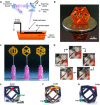Field responsive mechanical metamaterials
- PMID: 30539147
- PMCID: PMC6286172
- DOI: 10.1126/sciadv.aau6419
Field responsive mechanical metamaterials
Abstract
Typically, mechanical metamaterial properties are programmed and set when the architecture is designed and constructed, and do not change in response to shifting environmental conditions or application requirements. We present a new class of architected materials called field responsive mechanical metamaterials (FRMMs) that exhibit dynamic control and on-the-fly tunability enabled by careful design and selection of both material composition and architecture. To demonstrate the FRMM concept, we print complex structures composed of polymeric tubes infilled with magnetorheological fluid suspensions. Modulating remotely applied magnetic fields results in rapid, reversible, and sizable changes of the effective stiffness of our metamaterial motifs.
Figures





References
-
- L. J. Gibson, M. F. Ashby, Cellular Solids: Structure and Properties (Cambridge Univ. Press, 2001).
-
- M. Meyers, K. Chawla, Mechanical Behavior of Materials (Cambridge Univ. Press, ed. 2, 2009).
-
- Gibson L. J., Biomechanics of cellular solids. J. Biomech. 38, 377–399 (2005). - PubMed
-
- Wadley H. N. G., Cellular metals manufacturing. Adv. Eng. Mater. 4, 726–733 (2002).
LinkOut - more resources
Full Text Sources
Other Literature Sources

